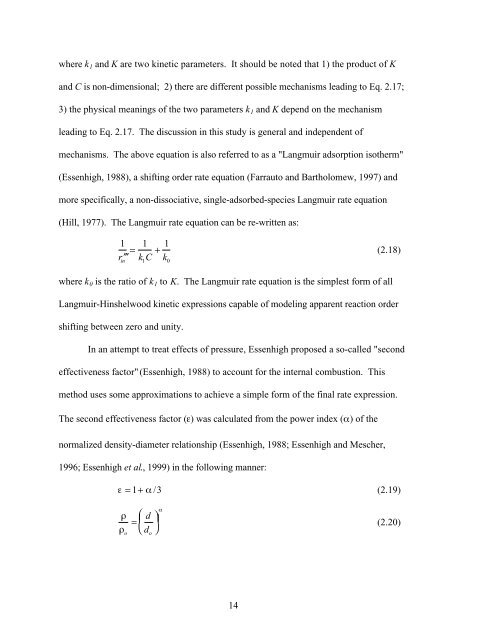MODELING CHAR OXIDATION AS A FUNCTION OF PRESSURE ...
MODELING CHAR OXIDATION AS A FUNCTION OF PRESSURE ...
MODELING CHAR OXIDATION AS A FUNCTION OF PRESSURE ...
Create successful ePaper yourself
Turn your PDF publications into a flip-book with our unique Google optimized e-Paper software.
where k 1 and K are two kinetic parameters. It should be noted that 1) the product of K<br />
and C is non-dimensional; 2) there are different possible mechanisms leading to Eq. 2.17;<br />
3) the physical meanings of the two parameters k 1 and K depend on the mechanism<br />
leading to Eq. 2.17. The discussion in this study is general and independent of<br />
mechanisms. The above equation is also referred to as a "Langmuir adsorption isotherm"<br />
(Essenhigh, 1988), a shifting order rate equation (Farrauto and Bartholomew, 1997) and<br />
more specifically, a non-dissociative, single-adsorbed-species Langmuir rate equation<br />
(Hill, 1977). The Langmuir rate equation can be re-written as:<br />
1<br />
r in′<br />
′ = 1 1<br />
+<br />
k1 C k0 where k 0 is the ratio of k 1 to K. The Langmuir rate equation is the simplest form of all<br />
14<br />
(2.18)<br />
Langmuir-Hinshelwood kinetic expressions capable of modeling apparent reaction order<br />
shifting between zero and unity.<br />
In an attempt to treat effects of pressure, Essenhigh proposed a so-called "second<br />
effectiveness factor" (Essenhigh, 1988) to account for the internal combustion. This<br />
method uses some approximations to achieve a simple form of the final rate expression.<br />
The second effectiveness factor ( ) was calculated from the power index ( ) of the<br />
normalized density-diameter relationship (Essenhigh, 1988; Essenhigh and Mescher,<br />
1996; Essenhigh et al., 1999) in the following manner:<br />
= 1+ /3 (2.19)<br />
o<br />
= d ⎛<br />
⎝<br />
⎜<br />
d o<br />
⎞<br />
⎟ (2.20)<br />
⎠
















